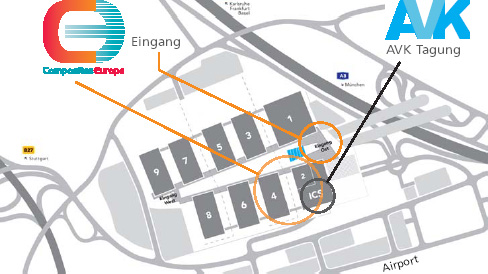
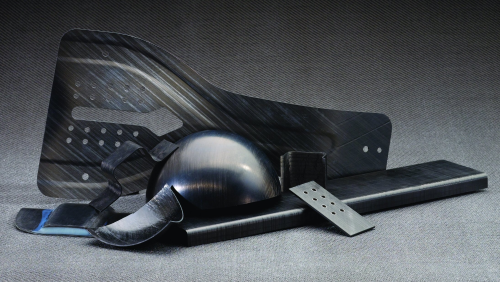
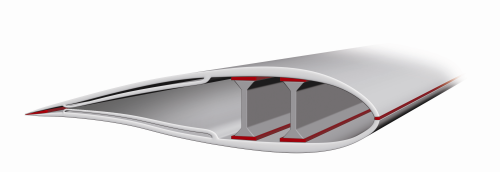
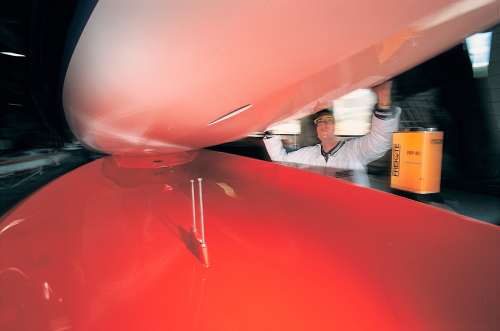
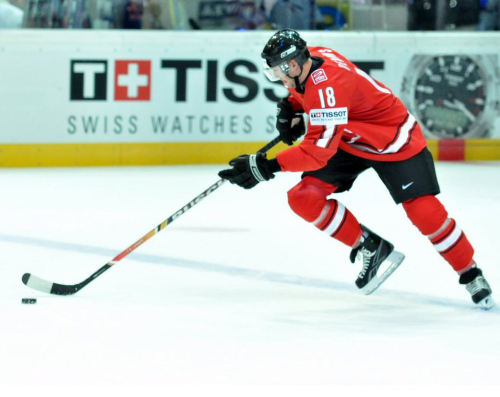

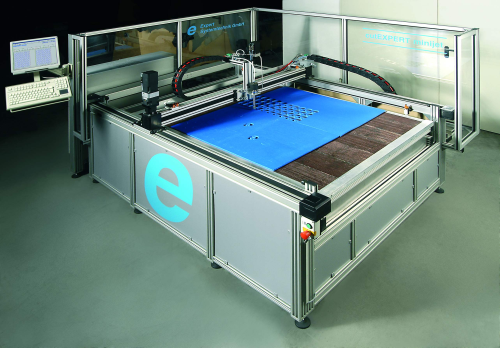
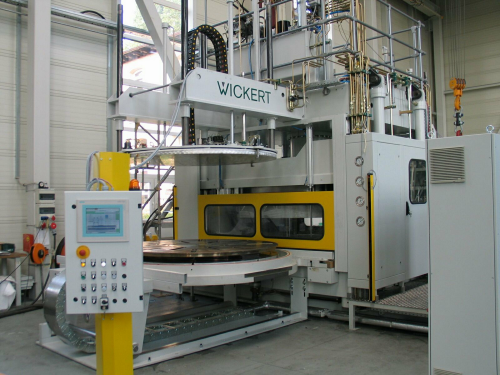
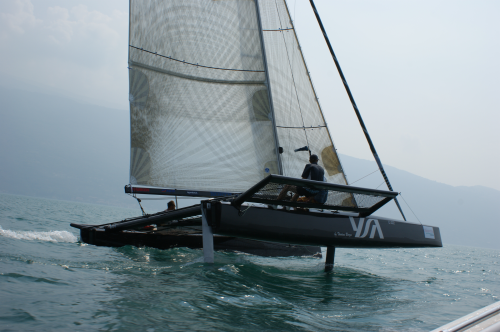
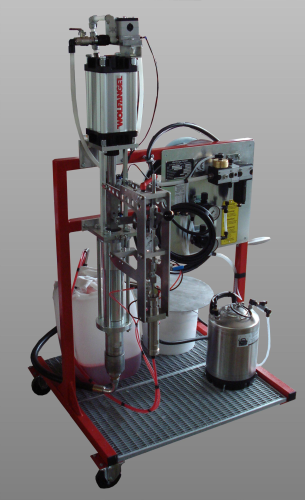
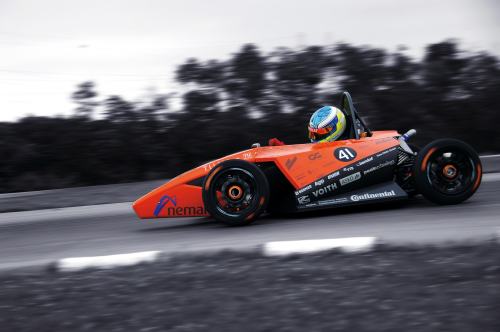
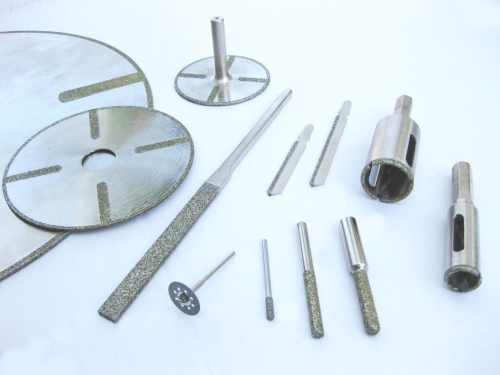
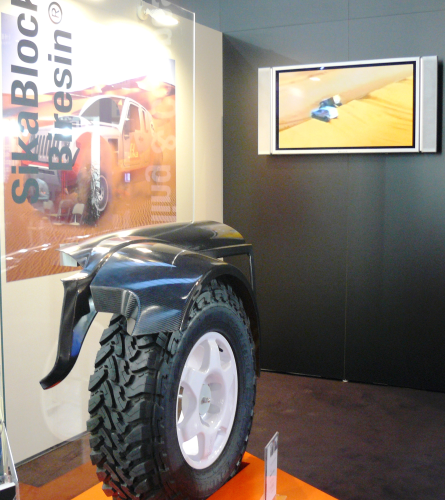
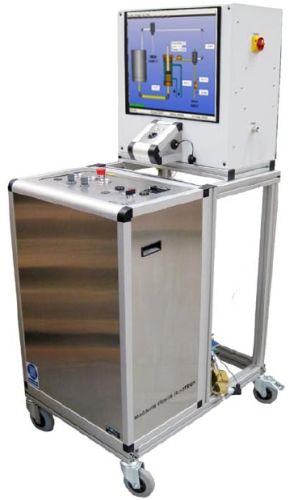

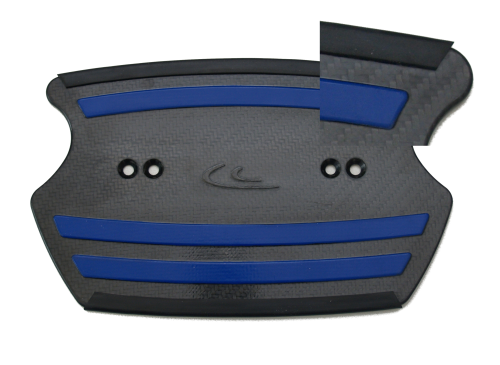
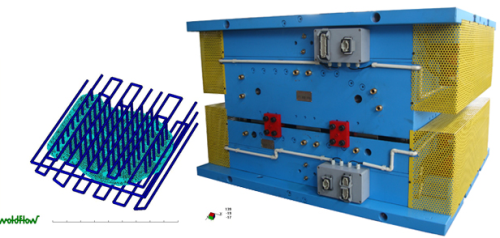
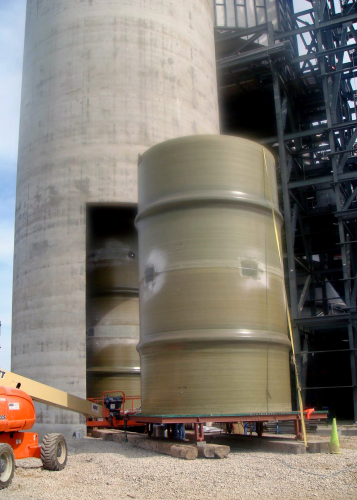
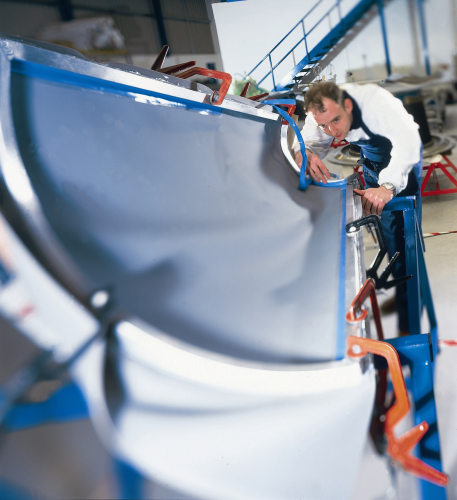
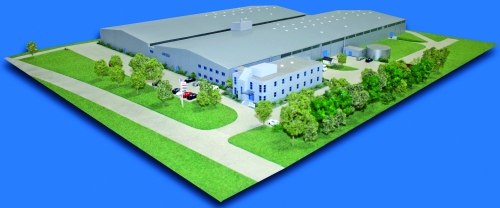
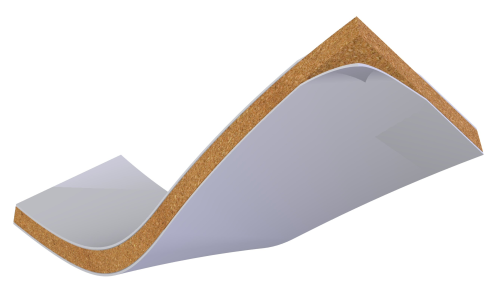
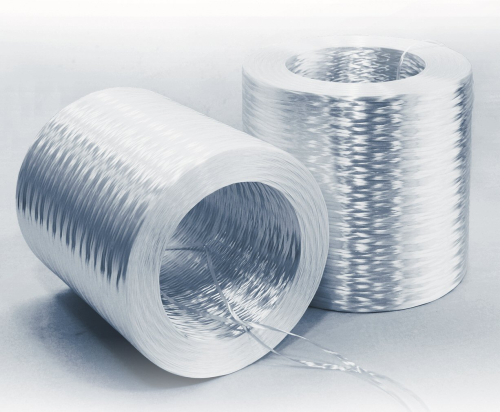
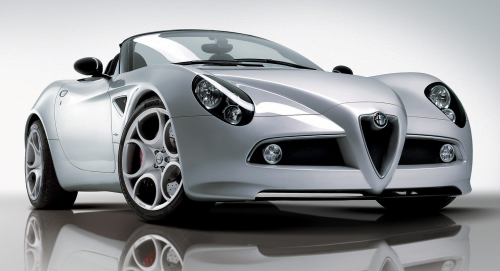
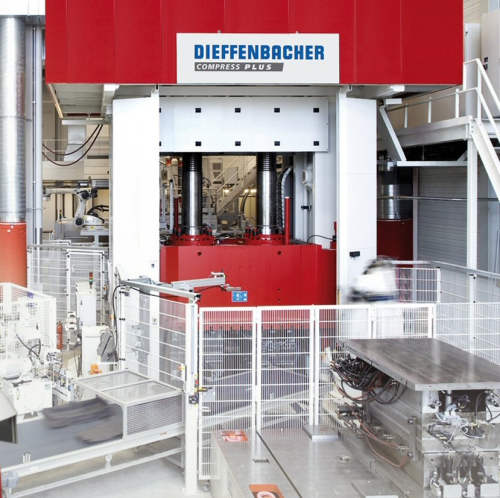
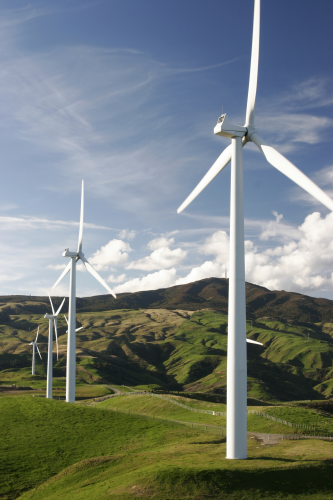
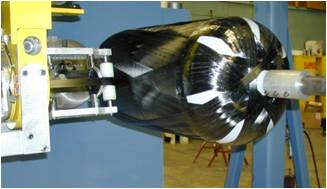
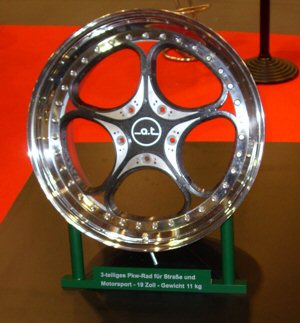
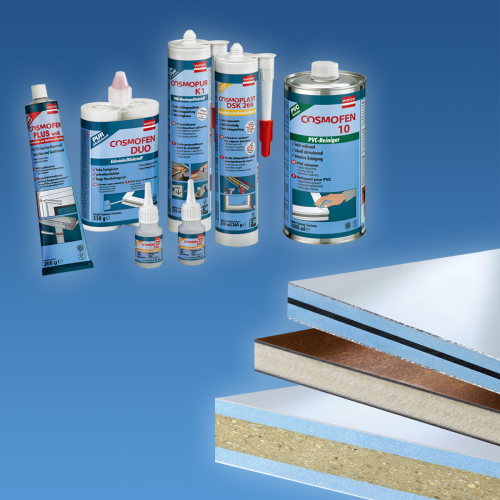

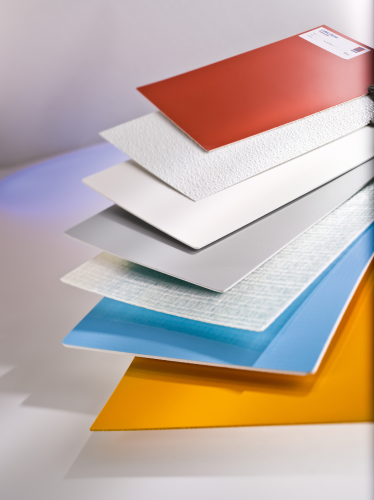
COMPOSITES EUROPE 2009 is organised by Reed Exhibitions in partnership with the European composites industry association EuCIA and Reinforced Plastics magazine. The International AVK Conference runs alongside the exhibition on 26-27 October.
In this preview we take a look at what exhibitors will be highlighting at the show. (Companies are listed in alphabetical order.)
a.t. carbon Hall C2 stand J15
Carbon wheels produced up to now either possess problems in terms of strength and stiffness or the manufacturing process is complicated and expensive and serial production is not realistic. a.t. carbon has developed a carbon wheel using a construction method which takes into account these issues.
a.t. says its wheels for motorcycles and cars with endless fibre reinforcement have already proved their structural strength and fatigue durability in the laboratory as well as on the race track. For motorsports application, a 13“ full carbon wheel was built with a weight of 2.3 kg.
a.t. carbon ltd is a small company founded in 2006, which does not yet possess its own manufacturing capacities. Therefore the first serial production of carbon wheels will be carried out by companies that have international quality certifications (ISO 9000).
Airtech Europe Hall 4 stand E14
Airtech Europe, the Luxembourg-based division of Airtech Advanced Materials Group, is upgrading its production capabilities for vacuum bagging materials.
The 8000 m2 expansion of the existing Luxembourg facility will accommodate more warehouse space and production equipment, including a separate area dedicated to custom engineered products. The new kit line will greatly increase the capacity and capability of producing vacuum bagging materials in customer-specified shapes. Kitted materials help composite part manufacturers by reducing production time, eliminating waste and controlling cost.
Airtech, a manufacturer of processing materials for the composites industry, offers auxiliary materials for vacuum bagging, wet lay-up, resin infusion processes. Its product range consists of: vacuum bagging films, release films and release liquids, pressure sensitive tapes, peel plies, breathers and bleeders, vacuum bag sealant tapes, vacuum bag connectors and hoses, rubber, tooling materials, carbon and glass reinforcements.
AKPA Chemicals Hall C2 stand D27
AKPA Chemicals specialises in producing organic peroxides, initiators, accelerators and paint driers. Its head office is in Istanbul, Turkey.
AKPA Chemicals mainly produces various types of methyl ethyl ketone peroxides, dibenzoyl peroxides in powder and paste forms, and paint driers in several concentrations. AKPA's products are used primarily for the curing of promoted unsaturated polyester and vinyl ester resins at room temperature or elevated temperatures. These standard products are formulated to meet the rigorous gel and cure performance demanded by fabricators. AKPA hardeners are suitable for phthalate free systems.
Over 70% of AKPA's products are exported to Middle East and European markets, as well as to North Africa and South Asian countries.
Alcan Composites Hall 4 stand E38
Alcan Composites, represented by Alcan Airex AG, will present details of its DRIVEN by ECO-LOGIC strategy, Hybrid Core Concept® and AIREX® T92 product, together with its German distributor Gaugler & Lutz.
Lightweight structures save valuable raw materials and reduce energy consumption which is equal to a reduction of carbon dioxide (CO2) emissions. For Alcan Composites this physically logical effect has become its ‘ECO-LOGIC.’ The company is continuously working on product optimisations which make lightweight construction even more attractive and thus actively support a sustainable way of doing business. Balsa, the only core material that comes from renewable resources, makes an important contribution to this goal. With the introduction of the new PET foam AIREX® T92 earlier this year, Alcan Composites has developed a product which is especially focused on sustainability through its extremely good recyclability and the use of a natural blowing agent (CO2). In the area of social responsibility, Alcan Composites is equally active.
The focus on sustainability forms the third pillar of Alcan Composites’ Hybrid Core Concept. Customers can choose from the broadest product range which allows them to find the product that best fits their requirements with regard to mechanical properties, price and sustainability.
Amorim Cork Composites Hall C2 stand D30
Amorim Cork Composites develops innovative cork composites materials for many industries. Its CORECORK® brand core material is the result of a combination of selected cork grains with a binder suitable to be in contact with the resins commonly used in the composites Industry.
Cork is a 100% natural raw material, completely renewable, which is stripped from the cork oak (Quercus Suber) every nine years. This process does not harm the tree because cork bark regenerates itself. This regeneration process stores carbon dioxide (CO2) and in the Iberian Peninsula alone, the cork forest captures more than 20 million tons of CO2. Although cork is the bark of a living tree, it is actually a conglomeration of cells. Each cell is a multi-sided polyhedron, only 30-40 microns in diameter and is filled with a gas almost identical to the normal atmosphere. Cork is made up of more gas (90%) than solid material, making its density very low.
CORECORK is available in sheets with thicknesses of 2-200 mm and it is successfully used in hand/spray lay-up, infusion and resin transfer moulding (RTM) manufacturing processes. The core material is compatible with polyester, epoxy, vinyl ester and phenolic resins, and also with the latest soybean-based polyester resins.
CORECORK can be used in the construction of glass fibre/carbon fibre sandwich panels used in many aerospace, marine, wind energy, construction, leisure (sport boats, skis, sport gear …), and transportation applications. CORECORK shows very interesting damping as well as acoustical and thermal insulation properties, thanks to cork’s natural properties.
AOC Hall C2 stand B19
AOC's Vipel® vinyl ester resins are now offered from manufacturing facilities in Europe. This gives specifiers, manufacturers and users of corrosion-resistant composites in Europe, the Middle East and Africa more flexibility to take advantage of AOC’s range of material technologies. Products available for shipment from Europe include standard bisphenol A vinyl esters, high elongation vinyl esters, and thixed and promoted systems.
At COMPOSITES EUROPE, visitors will learn how Vipel technologies and AOC service lead to corrosion-resistant material systems that are designed for success. AOC’s Case History library covers testimonials from composite manufacturers and their customers in the energy, chemical processing, food processing, infrastructure and other sectors where equipment is exposed to highly corrosive environments. Vipel vinyl ester technologies are also available for marine laminates, barriers and skin coats.
Vipel corrosion-resistant resins can be formulated to be process-friendly in filament winding, hand lay-up, spray-up, resin transfer molding, resin infusion and other composite manufacturing operations. AOC also offers technical service and support. AOC’s technical staff can provide formulation assistance, processing data, and relevant information on long-term chemical exposure and structural integrity.
Paul Bauder GmbH & Co KG Hall 4 stand C34
Paul Bauder GmbH & Co produces rigid polyurethane foam under the trade name BauderFOAM.
BauderFOAM is an excellent insulating and construction material and is suitable for numerous applications. It can be used for design models, for the form and model construction, but also, for example, for front door fillings, pipe isolation, sandwich elements and light domes.
BioStruct Hall C2 stand E25
EU-funded project BioStruct will present the latest material and processing technology in wood fibre composites during COMPOSITES EUROPE.
Within BioStruct, 20 partners from 10 European countries are developing enhanced wood plastic composites (eWPCs) for applications in automotive technology, electronics, construction and packaging.
"Modified wood and cellulose fibres will bind more effectively to the matrix polymers, leading to a significant improvement in the properties compared to conventional wood plastic composites, which are currently extremely successful on the market as a cheap alternative to unfilled plastics," says Dr Jan Diemart, BioStruct coordinator at the Fraunhofer Institute for Chemical Technology, Germany.
Wood-based composites have increased in popularity and interest in Europe during the last few years, mainly because of their commercial success in the US market and the rising prices for standard polymers. Environmental and ecological standards are also playing an increasing role in the process of developing new materials. BioStruct is considering the sustainability factor and is focusing on energy-efficient processes and resource-efficient production techniques.
The Fraunhofer Institute for Chemical Technology and project partners Net Composites and the European Composites Industry Association (EuCIA) will attend the COMPOSITES EUROPE show.
Carbo Tech Composites Hall 4 stand B35
Carbo Tech Composites specialises in the development of carbon fibre reinforced plastic (CFRP) parts for applications in racing, and the automotive and non-automotive sectors. The different product solutions have two things in common: optimal capability at minimal weight, and faultless surfaces.
Customers include Audi, Aston Martin, BMW, Bugatti, Lamborghini, Porsche, and Formula 1 teams Toro Rosso, BMW and Toyota.
Currently the production area at the company’s Salzburg facility is being extended to create additional capacity. Investments in research and development, improvement of workflow and processes, as well as in a professional and clean working environment, are important factors in Carbo Tech’s success.
Carbon Composites eV Hall 4 stand A16
The competence network Carbon Composites eV (CCeV) was founded about two and a half years ago in Germany. The association of companies and research institutions aims to promote and develop the national and international standing of carbon composites technology.
"Our activities are directed at developing high-performance fibre composite products that are ready for market – in particular for use in the transport, power and manufacturing sectors", explains the chairman of CCeV and CEO of Premium AEROTEC GmbH, Hans Lonsinger.
The association now has some 88 members and is still growing.
The following CCeV member companies will be on the CCeV stand at COMPOSITES EUROPE:
- Biersack Aerospace GmbH & Co KG;
- CADCON Ingenieurgesellschaft mbH & Co KG;
- C.F. Maier Europlast GmbH & Co KG;
- CG TEC GmbH;
- CMOR - Composed Materials Ohnhäuser & Rapp GmbH;
- DITF - Deutsches Institut für Textil- und Faserforschung;
- Kunststoff Wagner GmbH;
- LEUKA;
- MR PLAN GmbH;
- MT Aerospace AG;
- Peak Technology GmbH;
- Premium AEROTEC GmbH;
- Roschiwal + Partner Ingenieur GmbH;
- Teijin Monofilament Germany GmbH;
- Secar Technologie GmbH; and
- Die Wethje GmbH Kunststofftechnik.
Collano Adhesives Hall 4 stand D33
Collano offers a broad range of hot melt adhesive films and reactive hybrid adhesives.
Collano's hot melt adhesive films are ideally suited for applications in the transport industry (vehicles, aircraft, truck and railway platforms and superstructures, boats and ships, passenger and cabin compartments) and in house construction (interiors, acoustic panels, furniture). Hot melt adhesive films are used in the fabrication of lightweight structural components, honeycomb elements, and sandwich panels, including high-performance sandwich structures consisting of foam or honeycomb cores with cover layers of metal or fibre reinforced plastic. Hot melt adhesive films are clean, can be applied with precision and quickly processed, enabling a high degree of automation. Because preliminary coating of the substrates (such as honeycomb and/or cover layers) is possible in many cases, the films offer great flexibility and convenience of use.
Multilayer films are a speciality segment within the Collano hot melt adhesive films range. They allow incompatible substrates to be bonded, and impart additional functionality to composite or sandwich elements (barrier layers that repel undesirable substances, provide sound insulation, or stabilise process phases). Sandwich panel manufacturers often deploy multilayer films to split prelamination and completion into two separate thermal cycles.
Delta-Tech SpA Hall 4 stand C32
Delta-Tech is an independent company with the mission of providing products and services to the composites industry. Delta-Tech develops and fabricates resin matrices, while subsidiary Delta-Preg manufactures fabric and UD prepregs. To obtain the best results with prepreg technology, Delta-Tech provides technical support and specific solutions to part manufacturers, designers, consultants and OEMs.
To meet increasing demand in the automotive industry for high production output combined with cost effectiveness and Class A surfaces, the general trend is for out-of-autoclave processes. For these applications Delta-Tech has developed SIMS™, a ‘micro-sandwich’ consisting of a semi-impregnated needle-punched fleece, bonded between FRP skins. In the specific case of the composite underfloor fabrication for a GT car at I.T.C.A. Produzione, an opportunity was identified for cost cutting and increased production output by using pre-assembled prepreg/dry fabric plies and vacuum assisted moulding. I.T.C.A. designed and built an integrated moulding system where an electrically-heated mould was fitted with a removable heating chamber. This allowed the tool to remain in the same position through the whole production cycle. A self-release version of fast curing DT806R epoxy matrix was developed by Delta-Tech, in order to avoid periodic tool surface treatments. According to I.T.C.A. Produzione, the new moulding fixture, combined with the self-release SIMS™ material, reduced part manufacturing time by about 60% without any loss of mechanical and weight performance of the end product. This case history will be presented at the Composites Europe Forum on 27 October.
Dieffenbacher Hall 4 stand D41
Dieffenbacher will be presenting its manufacturing systems for forming fibre reinforced plastics. The company will be highlighting its cost effective production solutions for the manufacturing of lightweight car components and parts for the clean energy industry (such as solar panels).
Dieffenbacher supplies cost-effective production processes for composite automotive components, including presses for processing FRP, SMC (sheet moulding compound), GMT (glass mat thermoplastic compound), LFT (long fibre thermoplastic), combined extrusion/compression machines for the LFT-D-ILC technology for direct processing of rovings and thermoplastics. The company also supplies automated press systems and components for raw materials, part handling and remachining and automatic assembly systems for pressing in impact nuts, clips and hole reinforcements.
At COMPOSITES EUROPE the company will showcase its energy-saving Compress Plus press generation, advancements in the Dieffenbacher direct processes – LFT-D (long fibre thermoplastic, direct process) and D-SMC technology – and automated SMC processing.
DYNA-MESS Hall C2 stand A23
Testing machine manufacturer DYNA-MESS will present a new software programme for multi-axis, dynamic testing of composites. At COMPOSITES EUROPE, the company will demonstrate the new DYNA-TCC (Test Control Centre) software in a testing set-up with several servo-pneumatically actuated axes for dynamic tests of carbon fibre handlebars for bicycles.
Composite components subjected to complex loads must be tested under realistic conditions. Handlebars of bicycles, for example, must withstand heavy, low-frequency loads during acceleration from rest, and high-frequency loads on bumpy tracks. They must not break under extreme loads, for example, during downhill runs or jumps. DYNA-MESS says its systems are ideally suited to realising such varying load situations.
The software has been designed as a versatile tool enabling the user to realise individual solutions quickly and easily. This translates into a major cost advantage when it comes to implementing new testing tasks. The costs of the hardware components of servo-pneumatically actuated systems are substantially lower than those of hydraulic systems, and the cost advantage of a solution based on servo-pneumatics becomes especially obvious in the case of multi-axis testing systems. When performing tests of components, such as chassis or interior car parts or artificial hip joints, the new software controls up to 6 axes, either independently of each other or relative to one another.
The new software can be used with all servo-pneumatic testing machines supplied by DYNA-MESS and other manufacturers. For existing systems, an upgrade is available.
ebalta Hall C2 stand A17
Model and tool making specialist ebalta will be highlighting its new ebablock EP 138 product – an epoxy, cast to size block material, castable up to 350 mm in thickness. It has been developed primarily for prepreg tooling applications. This epoxy product complements ebalta’s current polyurethane cast to size product range.
Green in colour, ebablock EP 138 has a heat resistance of 135ºC and good dimensional stability, and results in a very smooth surface finish after milling to ensure the production of high quality composite components. It is also suitable for autoclave applications.
Like other ebablock materials, EP 138 can be cast as a customised, joint-less block to a customer’s individual requirements and offers savings through reduced milling times, less waste and minimal finishing.
One of the main exhibits on the ebalta stand will be a 6 m high, structural composite section of a boat deck, produced from carbon fibre and ebalta’s epoxy resin system AH 140. The part was produced using the vacuum infusion process for YSA/Sven Akermann GmbH, a yacht designer and manufacturer based in Schechen, Germany. AH 140, with a temperature resistance of 120ºC, was chosen for thus application because of its dimensional stability at elevated temperatures.
ebalta will also be showing its polyurethane P24 and epoxy P26 machineable, lay-up modelling pastes, used for large scale models or patterns in the wind energy, aerospace, automotive and marine industries.
ebalta also offers tooling boards, gel-coats, GL-listed epoxy resins qualified for laminating applications in the marine market, as well as a range of vacuum consumables.
Eligio Re Fraschini SpA Hall 4 stand D15
Founded in Italy in 1946 to manufacture wooden foundry models, Eligio Re Fraschini SpA has since specialised in the production of tools in metals and composite materials. Re Fraschini’s core business lies in the manufacturing of masters and tools for the production of high quality, high performance structural parts used in the automotive, aerospace, Formula One (F1) and race boat industries worldwide.
Examples of the company's successes include the manufacturing of the Hyperion car by Pininfarina, completely realised in carbon fibre, the Italian Excellence Award by Ferrari F1 team in 2007, and the cooperation with international nautical racing teams for events like the Americas’s Cup (Luna Rossa Prada), the Volvo Ocean Race (Ericsson, ABN Amro) and the Vendée Globe Regatta (Safran, Groupe Bel).
Eurocopter Deutschland GmbH, Tooling Donauwörth Hall C2 stand A04 At COMPOSITES EUROPE 2009, Eurocopter and its partner RAMPF Tooling GmbH & Co KG will present a comprehensive product range for the composites sector. Products include efficient casting systems, gel-coats, EP/PUR board materials with matching adhesives and repair pastes, seamless close contour castings for the production of lay-up tools and galvano bath models for composite parts, composite laminating systems with low viscosity and high temperature resistance, and the corresponding auxiliary materials.
The Eurocopter Tooling division is active internationally. In Donauwörth, Germany, tools are designed, built, documented, produced, examined, validated and supported. Maintenance, tool change management and optimisations are coordinated and controlled from Donauwörth.
Tooling technologies for composites include:
- moulding tools, trimming fixtures, bonding jigs and assembly line equipment;
- composite technologies: prepreg lay-up, RTM, VAP, pressure tube moulding etc;
- execution: tools in steel, CFRP, GRP, aluminium, nickel, Ni36 (Invar), ABS;
- manufacturing technologies: casting, welding, milling, forming, rapid technologies, electroforming etc;
- development: new tooling concepts like 'self adjusting tools,' flexible tooling, new manufacturing concepts like stitching, binders, lost cores etc.
Established in 1992, the Eurocopter Group is a division of aerospace and defence company EADS. Eurocopter has decades of experience in the construction and handling of prefabricated parts made from composite materials.
Expert Systemtechnik GmbH Hall 4 stand A02
Expert Systemtechnik GmbH was founded in Germany in 1994 to develop and sell fully automated EXPERT CAM cutting systems powered by waterjet technology or oscillation knife, and supported by EXPERT software modules. A modular design concept allows individual configuration to meet the customer's cutting requirements.
The CAD/CAM technology is used for cutting industrial fabrics, laminated materials, and composites.
Expert will be displaying the cutEXPERT minijet, a new, small cutter designed for prototyping, small sample runs and laboratory testing jobs, and the new single-ply cutting system cutEXPERT ecocam.
Extruder Experts Systems Hall 4 stand D22
Extruder Experts Systems is presenting its new NEXXUS technology for impregnation of endless fibres. The company, which specialises in twin-screw co-rotating extruders, has produced a NEXXUS extruder co-processor, which impregnates different endless fibres from rovings with a variety of polymers to form a homogenous mass, which can the be extruded into pellets, sheets or profiles. It is also possible to process different fibres, like glass and carbon, at the same time, to adjust the physical properties of the end product. The equipment can also process fibres and fillers or powders in the same process. For example, nano-particles can be dispersed and distributed gently, but effectively, and at the same time mixed with LFT polymers from roving.
Fiberforge Hall C2 stand E08
Fiberforge® is a manufacturing technology company focused on the development; prototyping and processing of continuous fibre reinforced thermoplastic composite parts. Its customers include aerospace, defence, transportation and electronics companies.
Fiberforge reports that its patented process, the RELAY® Station, produces highly consolidated, advanced composite structures faster and more efficiently than any other processing technology and reduces the manufacturing times to minutes per part. In addition, with greater throughput and repeatability, the Fiberforge process produces high performance parts that are more affordable then ever before. By reducing scrap, improving yield and minimising labour, the process offers customers a low total cost solution. Fiberforge's services include:
- design: Fiberforge has expertise in part design, engineering, material selection, prototyping, testing, process validation, finite element analysis, production implementation, supply chain management and quality control;
- prototyping: Fiberforge's on-site production cell provides customers with rapid, full scale prototyping capabilities, helping to reduce turn-around time and accelerate the design process;
- optimisation: because the Fiberforge process allows for variable thickness and directional fibre alignment within a single part, parts can be optimised to provide the best performance with the least amount of material, thereby reducing cost;
- manufacturing: Fiberforge can produce parts for the customer or install a production cell within their facility.
Flugzeug-Union Süd GmbH (FUS) Hall 4 stand A34
Flugzeug-Union Süd (FUS) is celebrating its 40th anniversary this year. Founded in 1969 as a logistics and trading company of the former MBB (Messerschmitt-Bölkow Blohm GmbH), FUS is now a subsidiary of EADS Deutschland GmbH and is located in Ottobrunn/Munich, Germany.
In addition to the entire range of Richmond Aerovac Products, FUS has been appointed official distributor of the complete range of vacuum bagging and tooling materials for Germany and various other European countries. The range includes cost-effective vacuum bagging films up to 12 m wide, reusable vacuum bagging systems with silicone membrane, a complete range of consumable materials, pre-fabricated bagging materials and tooling for the resin infusion process, and composite tooling.
By adding the Aerovac product range to the Richmond products that FUS has already been distributing for more than 20 years, FUS is now able to offer to the composites industry a complete range of vacuum process consumables. The range includes high- and low-temperature vacuum films, release films, breathers and bleeders, reusable vacuum bagging systems, resin infusion materials and tooling, Schnee Morehead® sealant tapes, PFG® peel plies, and Frekote® liquid release agents.
LAMILUX Heinrich Strunz GmbH Hall 4 stand B48
LAMILUX's high-grade decorated laminate, LAMILUX Graph, enables users to create aesthetically appealing wall panelling. The composite has high flexural and tensile strength and extremely low surface abrasion. Unlike decorative plywood products, LAMILUX Graph does not absorb any water it comes into contact with. As a result, condensation build-up doesn’t affect the material and its appearance in any way.
“Water cannot seep into this composite,” affirms Dr Gerd Puchta, Head of Research and Development in the Fiber Reinforced Composites Division at LAMILUX. "In the recreational vehicle sector, for instance, until now press board has been used for interior panelling. This swells up when it absorbs humidity and quickly succumbs to mould. There is no such problem with LAMILUX Graph."
"The decorative film is applied to the liquid resin at an early stage in the continuous production process, so both components are immediately permanently bonded together and turn into a sturdy composite once hardened," explains Puchta. "Due to the high chemical resistance this produces, the material cannot be damaged by household chemicals. As a result, LAMILUX Graph is very easy to clean. This sturdy material is also very durable due to its abrasion resistance and its considerable flexural and textile strength."
The range includes a variety of colours, wood effects from maple through to oak, stone effects, fantasy variations and tailor-made designs. Potential uses for LAMILUX Graph include: interiors for recreational vehicles and motor homes, vehicle construction, portable dwellings and offices, beach houses, healthcare facilities and washing amenities. It can also be used in interior design as well as for creative design for temporary structures in exhibition stand construction. Compared with timber-based products, LAMILUX Graph enables considerably thinner panels to be used, which can lead to a significant reduction in weight in pre-fabricated sandwich structures.
LAMILUX Graph can be supplied in rolls containing up to 120 m or as panelling. The décor paper bonded with the GRP has a maximum width of 2.10 m. The composite material is 1-4 mm thick.
Helm AG Hall C2 stand B06
Helm distributes products for The Jushi Group Co Ltd, located in Tongxiang, China.
Jushi introduced its new E6 ™ Enhanced Glass Fiber ™ at the China Composites Expo 2009 in Shanghai in September. Compared with typical E-glass fibre, Jushi E6 is reported to offer: tensile strength up to 15% higher than E-glass fibre; and softening temperature about 60°C higher than E-glass fibre. E6 is suitable for high pressure and high temperature applications. In addition, it maintains excellent electrical properties.
E6 glass fibre is said to provide a significant improvement in chemical corrosion resistance and is therefore particularly suitable for the applications in corrosive environments, such as chemical, oil and desalination process pipes and tanks.
Henkel Hall C2 stand C14 Henkel is exhibiting at COMPOSITES EUROPE for the first time and will be highlighting its expertise in structural bonding, mould release and high-performance resins.
Adhesive for turbine blades Wind tubine rotor blades have to withstand extreme stresses. Their quality depends not least on the reliability of their adhesive bonds. Germanischer Lloyd has certified the first polyurethane adhesive for the wind power sector: Henkel’s Macroplast UK 1340. This new technology is reported to offers benefits over epoxy systems, allowing wind turbine manufacturers to optimise productivity, improve quality and reduce costs.
Mould release A comprehensive range of Frekote mould release agents is available for composite systems including epoxies, polyester, vinyl ester and polyurethane. At COMPOSITES EUROPE a new Frekote water-based release agent designed for polyester gel-coat will be demonstrated. Customers will be able to view the mould release application process from preparation, cleaning and sealing, to applying the release agent. Best practice, ‘hints and tips’ and trouble shooting will be highlighted during the different application phases.
High-performance resins Whilst epoxy chemistry has served various industries for decades, Henkel is always searching for new methods to improve the structural assembly process. The goals of Epsilon resins are to enhance mechanical performance and durability, while lowering some of the costs associated with the composite structure during manufacture and service. As well as demonstrating low cure shrinkage, low water absorption and improved thermal stability, Epsilon resins offer processing ease, lower weight, and cost savings.
Huntsman Advanced Materials Hall C2 stand B04
In conjunction with the Philips Holst Centre, Huntsman has won an award for its Araldite® Highly Flexible Composite (HFC) for a new multi-layered composite foil. The composite foil combines organic light emitting device (OLED) technology with Araldite HFC and opens up a range of new lighting and signage design opportunities. Designers have the scope to create lighting and signage in shapes and forms that will not shatter or splinter on impact. The composite foil also has the potential to be 70% more energy efficient, and is more environmentally friendly, than other light sources. Corporate logos, brand names or warning signs can be creatively displayed on the spoilers of sports cars or motorbikes. Designers can add light sources on to flat carbon surfaces on furniture, aerospace and car interiors, and add style and safety features to items such as skis, snowboards and yachts.
Huntsman will also highlight two resins designed for the production of lighter weight graphite composite fuel cell bipolar plates. The resin for cars is based on benzoxazine and the resin for back-up power and stationary power applications is based on bismaleimide.
Huntsman is also exhibiting a range of materials suitable for the solar energy market, where products may have to withstand high temperatures. Materials on display include Araldite 2015, which is used in heat removal devices which improve solar panels efficiency.
Also on show will be Araldite EP1000, a patented concept based on nanotechnology which improves fracture resistance without affecting other properties. It is said to be ideal for the aerospace sector.
There is also an Araldite nanotech-toughened RTM product, in which the extremely small size of the nanostructures coupled with their extremely high surface-to-volume ratios leads to improved performance factors such as strength, stiffness and wear resistance. It has been used in the high impact sports sectors such as in ice hockey sticks.
Two new building blocks are being added to Huntsman's range of speciality epoxy resins suited for making high performance formulations intended for manufacturing composites parts for applications such as aerospace and Formula One racing. These are:
- Araldite MY 816, a resin based on a naphthalene backbone which offers a good balance between temperature resistance and toughness together with lower water uptake and good flame resistance; and
- Araldite MY0610, a high purity version of the meta-aminophenol based, trifunctional epoxy resin Araldite MY0600, which provides the same features as Araldite MY0600 with increased modulus, increased toughness compared to other multifunctional resins, improved stability on storage and lower viscosity.
Interland Company Ltd Hall 4 stand B58
Interland Company Ltd (the parent company of Litek Composite Xiamen Co Ltd) is professional FRP fabricator based in Xiamen, China. The company has 500 skilled workers producing all types of FRP hand lay-up flanges, fittings and pipes for corrosion application. Tooling for ANSI, JIS, DN standards is available for production. Vinyl ester resins like Derakane 411, 470 or its equivalent, Hetron 922, FR992SB are used in the company's.
Gummiwerk KRAIBURG GmbH & Co KG Hall C2 stand B14
KRAIBURG has developed a product that allows for the integration of a third, elastic material into fibre composite components without the need for an additional process. By using elastomer compounds at the desired points, it is possible to produce components with the following properties:
- up to 500% improved impact tolerance without visible damage;
- optimised vibration behaviour;
- direct integration of sealing functions into components;
- direct integration of joints; and
- extremely smooth and abrasion-resistant surfaces.
One area of application for this type of composite is the impact protection of components. By integrating rubber into the material, parts can withstand significantly higher impact energies. Initial tests show that the impact can be increased by factor of 5 before any damage becomes visible. The best results could thereby be achieved by combining hard (carbon fibre reinforced plastic/CFRP) and soft (rubber) materials in alternating layers. This design requires additional layers, but these have very low density (rubber: approximately 1.0; CFRP approximately 1.5).
By integrating a high-performance fabric into the elastomer layer, another problem can be successfully tackled, namely the crash properties of the component. In the event of a collision or similar impact, CFRP parts tend to break and shatter into tiny pieces. The fabric-reinforced elastomer layer is extremely tear-resistant and its strong bonding keeps the component in one piece, thus minimising fragmentation of the part.
A third advantage of the hard-soft-hard composite is its vibration damping effect on the component, as the rubber absorbs energy. In tests, the vibration period could be reduced by 75%. This allows for a significant improvement in the performance of fast-moving system parts (eg. robot arms) and improved acoustic properties due to noise reduction in parts with large surfaces (eg. engine bonnets).
If the outermost layer of the structure is made in rubber, impact protection and friction are improved, so that the component is effectively protected against mechanical damage (scratching) and aggressive media. Such composites useful for the production of steps and handles.
A variation of the composite includes CFRP, rubber and ultra high molecular weight polyethylene (UHWPE). PE has an extremely low friction coefficient and minimal abrasion values, but cannot be easily bonded with CFRP. With the new KRAIBURG composite, such combinations are now possible as the rubber is inserted between the layers.
The new composite material further allows for the elastification of certain sections of the component. This is for example useful for centre pieces of ducts in engine compartments, as relative movements can be compensated. Elasticised sections can also provide elastic/flexible hinged connections. Another possible application is the integration of sealing sections.
The key advantages of the new composite material are the direct integration into the production process, without any need for additional tools, processes or bonding agents, and its suitability for a wide range of processes (vacuum, autoclave, infusion, press), materials (CFRP, GRP, SMC, etc) and temperatures (80-200°C).
Kretzer Scheren GmbH Hall 4 stand A05
Technical fibres such as Kevlar are difficult to cut and cause the cutting edge to dull very quickly. Standard scissors do not cut glass fibres or aramids. For this reason, Kretzer designed the FINNY TecX1 and FINNY TecX2 series. These scissors easily cut aramid materials. TecX1 is made for glass fibre and light aramids, and TecX2 for heavy aramids. The scissors have durable plastic handles, are equipped with a smooth soft-rubber grip, and do not blister the fingers. Models with large loops make it possible to work while wearing gloves.
FINNY TecX contains 7 models per series. The size range runs from 6” to 12”.
Automobili Lamborghini Foyer/Reception
Italian car maker Lamborghini will display its new Murciélago LP 670-4 SuperVeloce at COMPOSITES EUROPE 2009. With a 6.5 litre V12 engine, 670 HP and a weight reduction of 100 kg (220 lbs), the car boasts a power-to-weight ratio of 2.3 kg (5.1 lbs) per HP. This gives it an acceleration of 0 to 100 km/h (62 mph) in 3.2 seconds and a top speed of around 342 km/h (212 mph).
In order to achieve the substantial weight reduction of 100 kg (220 lbs), the Murciélago LP 670-4 SuperVeloce was extensively reworked and redeveloped in virtually every aspect – from chassis to engine and transmission, right through to the interior.
The structure of the car is a composite construction of extremely stiff carbon components and a tubular steel frame. The transmission tunnel and the floor are made of carbon fibre, attached to the steel frame using rivets and high-strength adhesives. The roof and the exterior door panels are formed in sheet steel, while the remainder of the outer skin is made from carbon composite.
Lamborghini will also present a paper at the AVK conference: Carbon Fibre Composites Research and Development at Automobili Lamborghini. The speakers are Maurizio Reggiani, vice-president of R&D and CTO, Automobili Lamborghini SpA, Italy, and Paolo Feraboli, Professor and Director of the Automobili Lamborghini Composites Laboratory, Department of Aeronautics & Astronautics, University of Washington, Seattle, USA. The presentation will be divided in two sections. In the first section, Maurizio Reggiani will introduce the company's strategy to increase the power-to-weight ratio by reducing the overall vehicle weight while at the same time reducing emissions to meet stringent environmental regulations. The second section, presented by Paolo Feraboli, will review some of the company's R&D efforts in the areas of materials and processing as well as analysis and testing.
According to Paolo Feraboli, Lamborghini has decided to exhibit at Composites Europe/AVK this year because it is the largest composite event in Germany (an important automotive market), and because Germany is at the forefront of composites technology in Europe (many suppliers of carbon fibre material and parts for Lamborghini are based in Germany or Austria).
Magnum Venus Plastech (MVP)/CT Platon GmbH Hall 4 stand E7
MVP Ltd is exhibiting its new ThermoJect V6SC resin injection machine. This is designed to meet the processing requirements of single component resin systems such as Cytec Engineered Materials’ Cycom 890 or Hexcel’s RTM6, which require high levels of control and monitoring in terms of flow, pressure and temperature.
MVP says ThermoJect offers many improvements over equipment previously available for the advanced composite sector. Departing from the electrical method of heating, the ThermoJect V6SC uses hot water re-circulating through the machine’s entire resin fluid section to provide more accurate temperature control. This ensures that no cold spots and no over-temperature levels are to be found. This provides longer pot life of unused resin as its thermal ageing is decreased considerably.
The ThermoJect V6SC is powered entirely by pneumatics, and the water temperature control source can placed outside the moulding area and connected to the machine by simple flow pipes, thus safely removing all heavy duty electrics from the moulding area.
Pressure control set point can be adjusted between 0.5 and 10 bar using an all pneumatic pressure control circuit.
In operation, the resin is heated to approximately 80ºC. Whilst heating, the ThermoJect pump slowly re-circulates resin throughout its heated fluid sections back to the tank. In this way the whole system will achieve the same resin temperature. When injection needs to take place the injection valve is signalled, and accurate flow rates can be adjusted between 0.3-8 kg /minute into the heated mould cavity. The system is cleaned out using a non-volatile solvent such as Acrastrip at the machine’s operating temperature, leaving the machine’s fluid system clean and dry after cool down.
A large colour display allows the operator to monitor the current status of the machine.
MVP will also be introducing its PneuJect concept, which brings automatic features to an RTM machine without the use of electronics. The equipment is totally powered by air. Precision pressure and flow control, programmed catalyst changes, catalyst flow and level alarms are all featured on this one, fully pneumatic machine.
The PneuJect was designed with all working parts enclosed as the operator has no need access to these for production use. As and when the fluid section needs to be serviced the complete console cover is lifted off to allow access to the machine’s working parts. A switch on the control panel allows the catalyst ratio to be adjusted without accessing the pumps.
The adjustable boom and articulated mixing head provide coverage of over 10 m2 without the need to reposition the machine. The mix head has full recirculation auto valves with true position interlocks.
The PneuJect is supplied with pneumatic interface points for the newly introduced mould pressure and resin fill sensors and fluid container mounted catalyst and solvent level alarms.
The PneuJect offers the client the choice to employ safer pneumatic power and remove any concerns over electricity and point of ignition from the workshop environment.
MDC Mould & Plastic Co Ltd Hall 4 stand B52
MDC Mould & Plastic Co Ltd has an ISO 9001: 2000 approved factory in Zhejiang, Ghina. The company specialises in designing and making GMT/SMC/BMC/DMC moulds and products. Its main businesses are:
- vehicle parts: bumpers, engine hoods, underbody shields, front panels, truck doors, etc.
- SMC doors;
- sanitary parts: bathroom floor (tray), ceiling board, wainscot, wash basin, etc; and
- electrical components: electrical equipment boxes etc.
Moritz Diamantwerkzeugherstellung OHG Hall 4 stand A72 Moritz Diamantwerkzeugherstellung OHG produces high quality electroplated tools for the glass/carbon fibre industry. Besides a range of standard tools, tailor-made tools with a diameter up to 800 mm can be produced within a short time. Typically, MORITZ electroplated discs have four extra large side pads that ensure a constant side clearance in every cutting position. Specially engineered discs with shaft are offered for CNC machines. The disc and shaft are produced of one piece of steel that makes the tool resistant to high operational demands. Electroplated drills, milling tools and grinding pins can be manufactured in various dimensions.
At COMPOSITES EUROPE 2009, the company is offereing a tool kit with the most popular diamond tools for glass/carbon fibre at a discount price.
RAMPF Tooling Hall C2 stand A04 RAMPF Tooling will be focusing on high quality mould, model and tool making and lightweight construction techniques. The company offers a portfolio of liquid materials, pastes and boards designed for model and mould building, and also high-performance resin systems for lightweight construction. Target industries are machinery, marine, automotive but also the areas of renewable energy and aerospace.
RAMPF will highlight complex models from the aerospace and automotive industry. In cooperation with Eurocopter, RAMPF produced a galvano bath model out of RAKU-TOOL CC-6503 for the production of a helicopter roof. The production process for this part can be seen on the booth. With Bertrandt, RAMPF has produced prototype car door panels using resin infusion. During this project a process named Close Contour Casting (3C) was used to create close contour shape models through continuous vacuum casting. The mould into which the liquid material is cast is made using the customer's CAD data. Advantages of 3C are: fast machining; less tool wear; and less wastage.
”We supply the casting ready for machining and its shape is a very close contour of the final shape. This saves the user time and money,“ explains Heinz Horbanski.
RAMPF's distribution partner Esterhammer will display further projects, including an Audi R8 headlight and the Apollo racing car interior for which board material and Close Contour Paste were used in the production process.
Reinforced Plastics Hall C2 stand C35
Reinforced Plastics magazine is the official media sponsor of COMPOSITES EUROPE. Reinforced Plastics is the leading monthly magazine for the global composites industry. The magazine is available in both print and digital formats. Visit our website for all the latest composites news, detailed technical and market features, an events calendar, podcasts and webinars, jobs board, online Buyers' Guide, and a weekly e-mail newsletter.
Reinforced Plastics will have a Gumpert Apollo sports car on its stand at this year's COMPOSITES EUROPE.
Sika Deutschland GmbH, Tooling & Composites Hall C2 stand D15
Sika concentrates on two business areas: construction chemicals and industrial materials, eg. flexible adhesives and sealants, liquid resins; and solid machinable boards.
Sika´s Tooling & Composites products include block materials, model pastes, vacuum casting resins and RIM-Systems, gel-coats, laminating systems and epoxy and polyurethane-based casting resins. These are used for design/styling/cubing, rapid prototyping, tooling and part production in the automotive, marine, aircraft and wind energy industries. Sika develops customer specific epoxy and polyurethane matrix systems for the production of high performance composites for these industries.
At COMPOSITES EUROPE Sika is presenting its composite resin Biresin CR122 with hardeners Biresin CH122-3 and CH122-5 with Germanischer Lloyd approvals and with LBA approval for fibre reinforced parts for gliders and power gliders. Excellent mechanical properties for light construction and high glass transition temperature of approximately 120°C after appropriate post-curing are the features of these systems. The main application process is hand lay-up but, because of the optimised viscosity profile, the vacuum infusion of small to medium sized parts is also possible.
Sika's exhibits will also demonstrate its complete solution, from model to part, with a model produced from SikaBlock M450 with Biresin M72 paste finish, the heated mould with Biresin S8 gel-coat and on Biresin CR174 based composite, and the final part produced using Biresin CR120.
Weiss Chemie + Technik GmbH & Co KG Hall C2 stand D01
Weiss specialises in adhesive and sandwich panel technology. The range of COSMO adhesive systems comprises more than 400 different types of adhesives either for surface or constructional bondings, either superglues or special adhesives for different fields of application.
COSMO-Tech sandwich elements are lightweight designs in a sandwich construction. Solutions are available for automotive and container manufacturing, wall and ceiling elements, or for many other industrial applications.
Wickert Maschinenbau GmbH Hall 4 stand D05
Wickert Maschinenbau GmbH is exhibiting its large press programme for composites. It will highlight its vacuum chamber presses, which are becoming more widely used in composites processing.
Wolfangel Hall 4 stand C20
Wolfangel® supplies a range of equipment for the FRP industry, including polyester and epoxy injection machines, fibre spraying plants, gel-coat units with external mixing, and a gel-coat machine with internal mixing.
Vacmobiles, with integrated resin trap, vacuum pump and controls, are a complete vacuum system, not just a vacuum pump. In addition to the small and improved Vacmobile 20/2, Wolfangel will display the new Vacmobile modular on its stand. The considerably bigger and more efficient Vacmobile is particularly suitable for big parts that are produced using vacuum infusion or RTM light, such as wind turbine rotor blades.
In cooperation with AVK's Euro RTM Group, Wolfangel will demonstrate its technology daily at the COMPOSITES EUROPE Product Demonstration Area. Wolfangel will also team up with Zyvax on daily demonstrations of Zyvax's semi-permanent release agent .
Zoltek Hall 4 stand B29
Zoltek has developed new products focusing on a few of its key targeted applications: wind energy; automotive; and tanks for compressed natural gas (CNG).
Zoltek has developed heavy areal weight prepreg and fabrics for both the wind and automotive industry. Zoltek prepregs range from 150–600 g/m2, and allow for a rapid build-up of part thickness in wind blades or auto body panels. For those using an infusion or RTM process, Zoltek has developed carbon fibre fabrics that are easily infused with a variety of resins.
Zoltek has also joined forces with its Entec Composite Machines subsidiary to provide turnkey solutions for CNG tank manufacturers. For those interested in Type III and Type IV tanks, Zoltek and Entec are positioned to provide a full turnkey solution – which includes tank design, filament winding equipment and software, process know-how, and the carbon fibre reinforcement material. Entec’s engineering experience, together with Zoltek’s low-cost commercial carbon fibre provide a unique range of products and services for pressure vessel customers.
Zoltek’s most recently-developed product is a stretch-broken carbon fibre (SBCF) yarn, which is used in high-temperature packing and sealing applications, and also used to manufacture complex composite shapes.
Zyvax Hall 4 stand D38
Zyvax produces high performance, solvent-free, easy to use, mould preparation and release products which are available worldwide. The company is introducing two new brands at COMPOSITES EUROPE:
- BREEZ has been developed to meet the requirements of the wind power industry and includes one sealer and two release products;
- StayZ Spray Interface is a spray adhesive for use with RTM, Infusion and prepreg processes. It is an epoxy-based adhesive that provides tack plus a seamless bond strength to components such as metal, glass, carbon and other synthetic laminates.
| The International AVK Conference takes place on 26-27 October 2009, marking the start of the COMPOSITES EUROPE trade fair.
The conference programme offers up-to-date information and practical examples of applications in the following areas:
The Biowerkstoff-Kongress 2009 will also take place alongside the AVK conference. The winners of the AVK Innovation Prize will be presented during the 'Composites Night' on the evening of 26 October. The AVK – Industrievereinigung Verstärkte Kunststoffe eV (the German Federation of Reinforced Plastics) represents the interests of manufacturers and processors of reinforced and filled plastics, engineering thermosets as well as their raw materials suppliers on a national and European level. |
If your company is exhibiting at COMPOSITES EUROPE 2009 and you would like to be included in our website show preview, please contact us for details. The preview will also be published in the October issue of Reinforced Plastics magazine.
